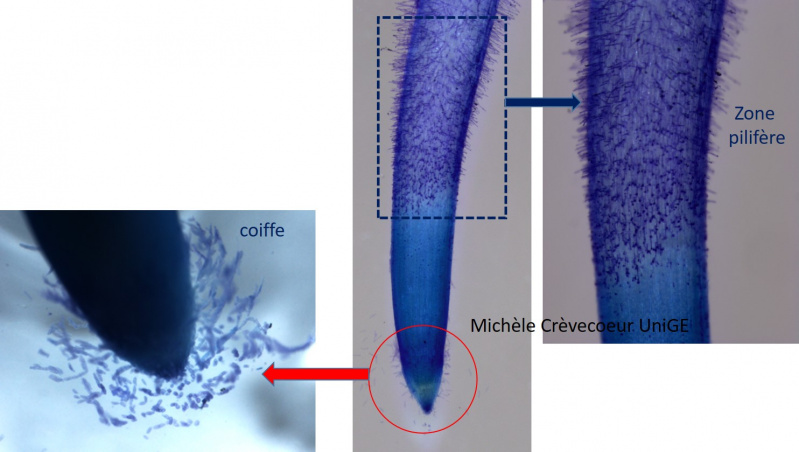Longitudinal section through a primary root of Zea mays.
Meristem – region of cell division
Below, light microscopy picture of a paraffin section (10 μm) stained with hematoxylin. On the right the quiescent center, the apical meristem, the column, central part of the root cap and the calyptrogen (meristem of root cap).
CQ : quiescent center; mec : meristem producing root cap: col: column (see also micrographs on the page hematoxylin staining).


Another staining of paraffin sections called «Gomori », appropriated for the staining of condensed chromatin as illustrated below with intense staining of mitoses in the meristem.


Root cap
The Gomori staining is also appropriated for revealing the chromatin fragmentation in the most distal part of the root cap. This is illustrated by figure below with the column, central region of the root cap constituted of parenchymatous cells (1) and the peripheral cells that slough from the root cap (red arrows). The root cap is in constant renewing.
On the right chromatin fragmentation in the most distal part of the root cap tip (blue circles). This is an example of programmed cell dead.


Root cap and hair zone can be easily identified on a whole root.
The root tip of a mays caryopse germinated for 48 h is immersed a few min in a drop of toluidine blue (0.55%) and immediately observed: root hairs and periphery of the root cap are well evident.

On the right: root hairs zone, with elongated hairs in older part of the root. On the left sloughed root cap cells around the root tip.
The different regions of a primary root.
The root cap is a kind of conic hood covering and protecting the root apex and the meristem. It derived from the calyptrogen, a specialized internal meristem adjacent to the root apical meristem. The central part of the root cap, the columella, consists in parenchyma cells rich in starch grains called statoliths. They are contained in amyloplasts and help in gravity perception and growth of roots towards the soil (positive gravitropism). In the distal region of the root cap sloughed cells are evident in the mucilage secreted around the root tip that facilitate the penetration of the root in the soil.
The quiescent center: based on different histological criteria (mitoses, nucleic acid synthesis) this region is considered as relatively inactive. However, it plays an important role in maintaining the root cap and in replacement of the meristem if this one is damaged.
The region of cell divisions includes the apical meristem and the 3 primary meristems derived from this one: protoderm, ground meristem and procambium. The meristem contains cells that divide continuously, generating the cells that make up the root.
The elongation zone contains cells that elongate rapidly, about 10 times faster than meristems. With the meristem it participates to growth of the root and is responsible for the growth of the root in length.
The root cap and the root hairs region have two common characteristics: they are in constant renewal, and they produce mucilage which facilitate the penetration of root tip and root hairs in the soil.
The zone of maturation where cells gradually mature into and differentiate into different tissues. The root hairs are found in this maturation zoneabove the elongation zone and extend on several centimeters. Root hairs are characteristics of young growing roots. There are microscopic outgrowths from specific epidermal cells and have thin cellulosic walls. Their density varies with species and in relation with the environment conditions. Root hair cells vary from 0,1 to 15 mm in length and 10 to 15 µm in diameter. They greatly increase the surface area of the root and are essential for absorption of water and minerals from the soil.
Lateral roots are generated in a region above the hairs zone. It is a process of organogenesis initiated in pericycle.